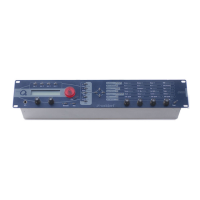Sound Parameters – Arpeggiator
Waldorf microQ User´s Manual 102
● ●●● ●●● ●●● ●●
●●● ●●●● ●
●●●●●●●●●●
●●●●●●●●● ●
●●●●●●●●●●
● ●●●●●●●●●
●●●●●●●●●
●●●●●●●●●
●●● ●●● ●●● ●●●
●● ●● ●● ●● ●●●
●● ●● ●● ●● ● ●
●● ●● ● ●●●●●
●●●●●●●●●●
●●●●●●
●●●●● ●●●
1
2
3
4
5
6
7
8
9
10
11
12
13
14
15
Pattern 1 2345678910111213141516
Picture 29: Arpeggiator patterns
Note that you can edit a ROM pattern to create your own rhythms starting from an existing
ROM pattern. As soon as you do so, the ROM pattern is copied to the User pattern and the
previous User pattern is overwritten.
Max.Notes! Clock
16 ! 12/192
Max. Notes 1…16
Sets the maximum number of notes that are used for the note list. When you press more notes than set
up here, the oldest notes are removed from the list. This feature is particularly interesting in Multi
Mode. When you set it to 1 on a Bass sound, for example, the Arpeggiator only stores the last entered
note and plays back sequentially. All other notes might still be used by other sounds, but the Bass
sound plays back only this one particular note.
Clock 1/32t…1/1
Sets the note value for the steps of the rhythm pattern in a range from whole notes to thirty-second
triplet notes. Triplets (e.g. 1/8T) and dotted notes (e.g. 1/16.) are available for every note value.
Length ! Oct.Range
12/192 ! 1
Length 1/192…127/192 / legato
Sets the length of the generated arpeggio notes. When Length is set to a value between 1/192 and
127/192, the Arp Steplen parameter lets you change the relative length of each step. However, when
Length is set to legato, all arpeggio notes are played without pauses between each step and Arp
Steplen therefore has no effect.

